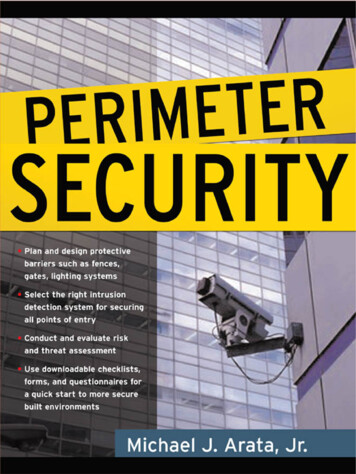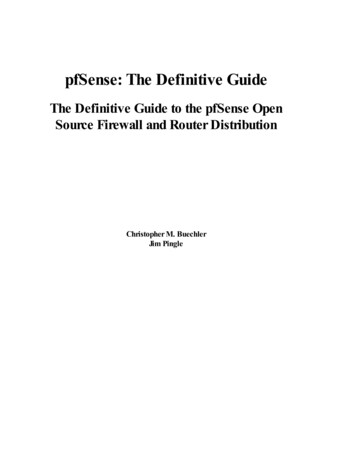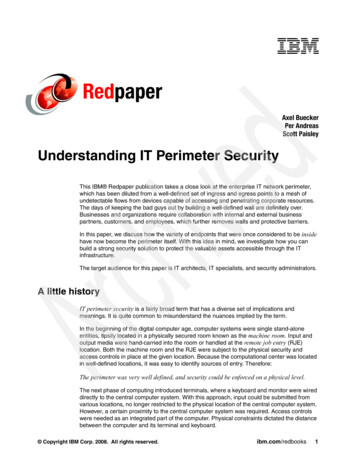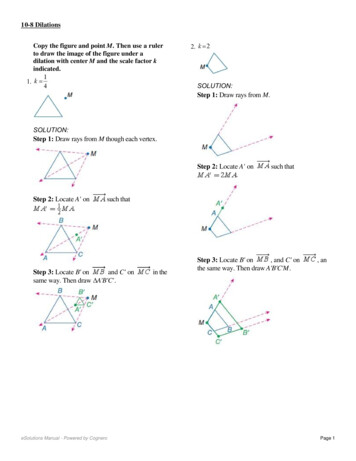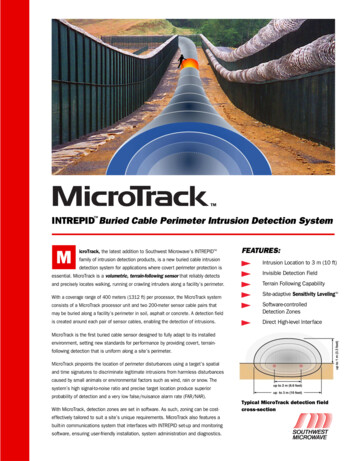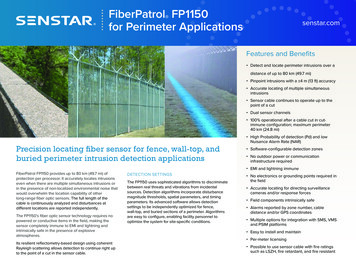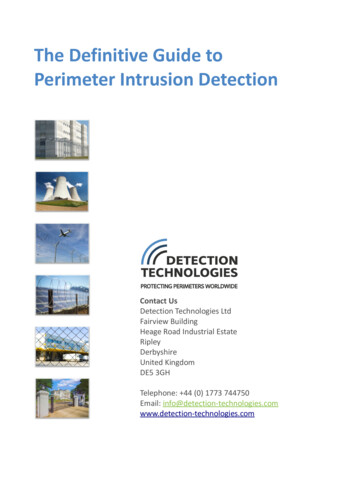
Transcription
The Definitive Guide toPerimeter Intrusion DetectionContact UsDetection Technologies LtdFairview BuildingHeage Road Industrial EstateRipleyDerbyshireUnited KingdomDE5 3GHTelephone: 44 (0) 1773 744750Email: ologies.com
Page 2 of 11IntroductionFrom prisons to private homes, stadiums to schools, the need for security isconstantly rising. More and more buildings and properties require perimeterintrusion protection to prevent unauthorised access.The variety of perimeter intrusion detection systems (PIDS) available is huge.Comparing different types of PID technologies is difficult and time-consuming sincemany factors must be taken into consideration to choose the most suitabletechnology to secure a site.This guide intends to provide an overview about the most commonly used PIDtechnologies in perimeter protection and discusses their applications. The Centre forthe Protection of National Infrastructure (CPNI) clusters PID systems as follows: barrier-mounted systems free-standing systems ground-based systemsGuide SummaryEvery site has unique characteristics and faces individual threats. There is no one PIDtechnology that suits all sites. Depending on your available budget it makes sense tocombine two or more technologies to achieve the best result. The table belowsummarises the findings of this guide in detail:Barrier-mounted PIDS such as VibraTek Plus sensor cable and VibraFon pointsensors belong to the most widespread intrusion detection technologies. They areinstalled directly at the perimeter fence or wall and therefore identify an intrusionright at the beginning. They can cater for non-linear perimeters such as perimeterswith corners or other directional changes. Moreover, they are known to work well in
Page 3 of 11unfavourable weather conditions and darkness. Both technologies have built-inaudio alarm verification so that security staff can listen to the audio signals thatcaused an alarm. Both systems are an excellent solution where high performanceand moderate investment are required.Free standing PIDS such as active infrared or microwave systems are often used forperimeters that include wide open spaces with few obstacles, such as buildings orother obstructions. Besides that, infrared systems are ideal to protect shortdistances such as windows or facades of a building. For very high securityapplications free standing PID systems are combined with barrier mounted systems.Whereas the latter protects the fence itself, the former detects the area behind theperimeter fence/wall.CCTV has become more effective in recent years. The huge advantage of visual alarmverification has to be paid with a heavy investment in the technology. CCTV withadvanced analytics is not without flaws when it comes to reliable intruderidentification and effectiveness in bad weather conditions.Due to their high costs and complexity ground-based PID systems are often onlyselectively applied in very high security areas within a perimeter. More and morefree-standing systems are preferred in these scenarios. What makes buried systemsoutstanding is that that they are completely hidden which makes it very hard for anintruder to plan a strategy to defeat them.
Page 4 of 111. VibraTek Plus Microphonic Sensor SystemVibraTek detection technologies represent some of the most reliable and costeffective perimeter detection tools available on the market. VibraTek Plus is thefourth-generation vibration-sensitive linear sensor specifically designed to providehigh-performance intruder detection capability when deployed on fences or otherbarriers used to define the perimeter of a secure site. Compared to other PIDtechnologies an intrusion is identified right at the perimeter boundary, and moreimportantly, before the intruder gains entry to the site thereby giving security staffmore time to implement effective countermeasures.The VibraTek Plus microphonic sensor detects mechanical vibrations which are thenconverted into electrical signals that accurately represent the mechanical energywhich caused the signal. The VibraTek Plus uses software algorithms to reliablydifferentiate between non-hostile signals, such as those caused by wind, rain, hail, orother environment related activity.The huge advantage of sensor cable is that it covers the perimeter boundary over itsentire length. Environmental factors usually affect the whole perimeter boundarywhereas intrusion-related activity tends to be localised at the point of attack.Moreover, smart configuration options prevent alarms generated by larger animalstouching the perimeter protection structure.
Page 5 of 11Unlike some of the competing intrusion detection technologies VibraTek Plus isvery durable in adverse weather conditions, including heavy rain and fog. Mostimportant, the alarm effectiveness won’t be compromised by darkness, rain, hail,snow or sandstorms. The system doesn’t require a clear line of sight. This makes itideal for sites which have bends and corners that create niches and ‘hidden’ areas.If the height of the perimeter barrier is restricted for aesthetic or planning reasons(for example the building lacks a security topping) an intruder might try to bridge thestructure with a double ladder. To eliminate this possibility VibraTek Plus can beused in conjunction with a free standing or ground-based PID system.VibraTek Plus comes with the distinct advantage of offering a clear and very highquality audio representation of any form of ‘hostile’ or intruder-related activity. Thismeans that security staff working in the site control room can easily ascertain thenature of any suspicious intrusions and act accordingly in a time-efficient manner.This ‘audio verification’ feature offers security staff the opportunity to ‘listen’ to theaudio signal caused by intruder-related activity. This audio signal is identical to theaudio they would hear if they were standing next to the intruder while the intruderwas attacking the fence.In terms of costs the microphonic sensor is very attractive because it usually onlyrequires running a single communication cable from the protected building to theperimeter boundary.ProsReliable and affordable technologyResilient to bad weather and darknessDoes not require a clear line of sightPerimeter structure can include bends andcornersIn-built audio alarm verificationConsPerimeter structure needs to be touched tocause alarms
Page 6 of 112. VibraFon Seismic Sensor SystemThe Ultimate Wall Protection System, known as VibraFon , is perfect for propertieswith a high number of major walls and other concrete constructions, particularlythose with bends and corners, as opposed to large, open spaces. Like VibraTek Plus,it is a barrier-mounted PIDS providing audio alarm verification upon detection.VibraFon works by utilising seismic point sensors which are able to detectmechanical vibrations passing down the perimeter as an intruder attempts to scaleor penetrate it. Spaced roughly three metres apart, the sensors create aninterconnected network to detect hostile activity. One signal analyser canaccommodate zones of up to 100 metres in length (32 sensors) and can be placedclose to the wall (which requires DC power and cabling) or up to 2500 metres awayusing dual twisted cables.VibraFon is one of the most covert perimeter detection products on the market.The part of the system located along the perimeter wall also does not need anypower distribution in order to function. It can be installed inside the wall withoutcausing any significant visual impact.Unlike many of its main non-vibration competitors, this system does not need to relyon direct linear detection like infrared systems might have to. Thanks to itscomprehensive signal filtering capabilities, the VibraFon system can easilydiscriminate between hostile activity (such as a burglary) and benign activity (likepassing traffic or severe weather.) As such, its effectiveness isn’t compromised bythe weather or darkness, and it can still operate effectively in areas of overcrowding.ProsRelatively affordable infrastructure andinstallation costsNot visible if installed in the wallResilient to bad weather and darknessDoes not require a clear line of sightAudio alarm verificationConsWall might be bridged
Page 7 of 113. Active Infrared Systems (AIS)An active infrared system (AIS) consists of a transmitter and a receiver. Thetransmitter emits an infrared beam that is not visible to the human eye. If the beamis interrupted the receiver generates an alarm. Heavy fog may cause false alarmssince the beam cannot reach the receiver. Often multiple beams are arranged tobuild a curtain whereby two AIS towers face each other.The ideal perimeter to be protected with AIS is rectangular with four perfectlystraight sides 200m. In this case freestanding AIS would be an effective solutionsince you only need to install one pair of transmitters / receiver towers next to thefence line per side. Unfortunately, the reality looks different. Most of the perimeterboundaries have bends, corners and hilly grounds which make it difficult andsometimes even impossible to secure them with AIS only.Although one transmitter and one receiver can cover a range of a few hundredmeters in theory the alignment of transmitters and receivers over long distances canbe tricky. Unfortunately, they do not indicate the location of an intrusion in betweentwo towers.A clear line of sight between the transmitter and the receiver is always a prerequisitewhich narrows down the applications. AIS are a popular means to protect smallerdistances such as windows, facades, boom barriers or sliding gates and are thereforea good extension to barrier-mounted PIDS. AIS technology is a valid solution toprotect a perimeter where no physical barrier is wanted.AIS systems can be quite expensive because each transmitter and each receiverrequires a separate power and communication cable. To ensure reliable functioningin low temperature conditions the AIS need to be heated. If multiple AIS systemsneed to be deployed to protect larger perimeters, it is usually a requirement that asynchronisation cable must be installed between adjacent transmitters and receiversto avoid interference. This cable is normally installed in a cable duct below theground and adds significantly to the installation cost.One of the biggest drawbacks of AIS is that there is no integrated method to verifyan alarm. In other words, without CCTV the security staff has no means to verifywhether the alarm was caused by an intruder or accidentally by wildlife.
Page 8 of 11AIS defeat strategies might include bridging over or tunnelling under infrared beams.Depending on the size of the beam tower it might act as a climbing aid for theintruder.ProsIdeal to secure short distances such aswindows or barriersMedium costs compared to other PIDSConsClear line of sight between receiver andtransmitter inevitableNot for perimeter structures with manycorners and bendsRisk of false alarms in foggy conditionsNo way to verify the location of the intrusionNo alarm verification4. Microwave SystemsMicrowave technology can be either bistatic or monostatic. Monostatic systemscombine the transmitter and the receiver in a single device. They work by filling all ofthe open space inside a specific area with electrical signals and then monitoring howlong it takes for the signals to be reflected back. If it takes longer than expected analarm is triggered.Bistatic microwave systems consist of a transmitter, a receiver and a microwave field.A moving object causes a detectable change in-the microwave field. However, it issometimes difficult to determine whether that object is a human or an animal.The accidental activation of security procedures following a false alarm can be costlyto a business and could even cause the directors to run into trouble with localauthorities. While it's true that developments in microwave perimeter defencetechnology (such as the capacity to only trigger the alarm once a bespoke operatingfrequency has been reached) has helped to reduce the number of unwanted alarmsthere's still a way to go.One of the major advantages of a microwave perimeter detection system comparedto active infrared systems is that they tend to be more reliable in bad weatherconditions such as heavy fog, rain and snow. One of the major challenges formicrowave detection systems is the susceptibility to movement of water within theprotected areas. For example, a pool of water lying on the ground within themicrowave beam will cause false alarms if the wind is sufficiently strong to causeripples on the surface of the water.
Page 9 of 11Both free-standing technologies work best in sweeping, open environments. Intheory, they can protect a perimeter without a fence construction. However, aphysical perimeter boundary is always preferable since it adds an extra layer ofsecurity. On the contrary, both systems have difficulties securing areas with lots ofsmall outbuildings or other obstructions.The cost of microwave systems depends on the application. If a single straight-linedetection is sufficient to secure a whole perimeter it is very affordable. With morecomplex sites, cost can add up very quickly since every unit requires power andcommunication connection.ProsUseful to protect open space areasReliable in bad weatherRelatively low cost of installation,infrastructure, software and hardwareConsNot effective for sites with bends, corners orareas of overcrowdingAnimal movement may lead to false alarmsNo built-in alarm verification4. CCTV Systems With Motion DetectionCCTV with motion detection is one of the most well-known visual perimeterintrusion detection systems on the market. This free-standing PIDS works byconstantly monitoring fields of vision for changes in movement to suggest anintruder is present. Each frame is stored in the system and is used to monitorchanges sequentially. This is registered in the video voltage and may be representedon screen as a change in brightness. If the following frame shows another change,for example, the subject has moved again, it triggers an alarm to alert securitypersonnel.Motion detection CCTV has come a long way. The first systems introduced claimed tohave reliable motion detection. However, the performance was poor and false alarmrates were very high. Technology is improving all the time and today's advancedmotion detection systems have become more reliable. They include video analyticswhich allows users to adjust for variations in local conditions, or regarding speed,direction of movement and object size. All this has helped to lower false alarm rates.However, CCTV with motion detection still has its drawbacks.CCTV systems still struggle to differentiate humans from similar sized objects such asanimals. Furthermore, certain weather conditions are a challenge for motiondetection CCTV. Lightning strikes can cause unwanted alarms. Fog and heavy rain canprevent the line of sight. Besides that, darkness also requires special CCTV
Page 10 of 11technology. To overcome these challenges, CCTV is often combined with barriermounted PID systems.CCTV with motion detection belongs to the most expensive PID technologiesavailable. Several cameras need to be placed along all stretches of the perimeter toavoid blind spots. Usually, each camera requires its own camera post as well as dataand power connections. On the plus side, they can be positioned in buildingsinternally or externally, including those with bends and corners.Another challenge for CCTV with advanced analytics is to secure a defined areawithin the line of sight where lots of moving objects are expected. For example, youcannot protect a fence construction against climbers when people are walking infront of or behind that fence construction.ProsVisual alarm verificationReal-time monitoring and recordingCan be employed in sites with bends andcornersConsRisk of false alarms due to bad weather andcrowded areasVery expensive infrastructureHigh installation costs as it requires CCTV alongthe entire perimeter5. Ground-Based SystemsGround-based PIDS are installed below ground level. Intruder activity above theground is usually measured by pressure sensitive sensors, seismic sensors, or radiofrequency sensors. The result is an apparently invisible perimeter protection systemwhich cannot be tampered with and which is impervious to bad weather conditionssuch as fog, darkness or heavy rain.If an intruder is detected above ground security staff receive a warning so that theindividual can be intercepted. As such, this technology doesn’t require a clear line ofsight to work and can be used on large or complex sites. The kinds of movement thatcan be detected include digging and drilling, vehicle movement and footsteps,among others.The main reasons why ground-based systems are not widespread is the hugeinvestment required. Since the PID systems are buried into the ground there is a lotearthworks necessary to install the system. Maintaining or repairing the system iscomplex and costly, too.
Page 11 of 11A major problem for ground-based systems is to differentiate between animals andhuman activity. More sophisticated systems try to solve this problem with machinelearning technology. However, these sophisticated models are still subject to falsealarms. Unfortunately, the technology lacks a means to verify alarms.The most common defeat strategies are to cushion the vibrations caused bymovement with either ladders or pads.ProsNot visible for the intruderReliable in bad weatherDoes not require a clear line of sightCan be employed in sites with bends andcornersContact UsDetection Technologies LtdFairview BuildingHeage Road Industrial EstateRipleyDerbyshireUnited KingdomDE5 3GHTelephone: 44 (0) 1773 744750Email: ologies.comConsRisk of false alarms due to animal activityVery expensive to install and maintainCannot be used in crowded areasRelies on prevention; would be best utilisedwith another PIDSNo built-in alarm verification
Barrier-mounted PIDS such as VibraTek Plus sensor cable and VibraFon point sensors belong to the most widespread intrusion detection technologies. They are installed directly at the perimeter fence or wall and therefore identify an intrusion right at the beginning. They can cater for non-linear perimeters such as perimeters


